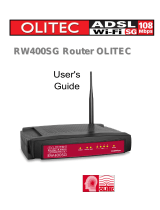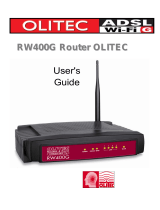Page is loading ...

CMP-WNROUT10
Wireless Router
Quick Installation Guide
1 System Requirements
Broadband Internet Access Service (DSL/Cable/Ethernet)
One DSL/Cable modem that has an RJ45 connector (you do not need it if you connect the
router to Ethernet)
Each PC on the LAN needs a working Ethernet Adapter and an Ethernet cable with RJ45
connectors
TCP/IP protocol must be installed on each PC
Web browser, such as Microsoft Internet Explorer 5.0 or later, Netscape Navigator 6.0 or
later
1.1 Connecting the Router
Before you install the router, you should connect your PC to the Internet through your broadband
service successfully. If there is any problem, please contact your ISP. After that, please install
the router according to the following steps. Don't forget to pull out the power.
1. Power off your PC(s), Cable/DSL modem, and the router.
2. Locate an optimum location for the router. The best place is usually near the center of the
area in which your PC(s) will wirelessly connect.
3. Adjust the direction of the antenna. Normally, upright is a good direction.
4. Connect the PC(s) and each Switch/Hub on your LAN to the LAN Ports on the router,
shown in figure 1-1.
5. Connect the DSL/Cable Modem to the WAN port on the router, shown in figure 1-1.
6. Connect the AC power adapter to the AC power socket on the router, and the other end
into an electrical outlet. The router will start to work automatically.
7. Power on your PC(s) and Cable/DSL modem.
To LAN
Switch/Hub
4321WAN
To WAN
RE SE T
£¨£©XDSL Cable Ethernet¡¢¡¢
Figure 1-1: Hardware Installation of the CMP-WNROUT10 54Mbps Wireless Router
After connecting the CMP-WNROUT10 into your network, you should configure it. This chapter
describes how to configure the basic functions of your CMP-WNROUT10. These procedures
only take you a few minutes. You can access the Internet via the router immediately after
successfully configured.
1.3 TCP/IP configuration
The default IP address of the CMP-WNROUT10 is 192.168.1.1, and the default Subnet Mask is
255.255.255.0. These values can be seen from the LAN. They can be changed as you desire, as
an example we use the default values for description in this guide.
Connect the local PCs to the LAN ports on the router. There are then two means to configure the
IP address for your PCs.
Configure the IP address manually
1) Set up the TCP/IP Protocol for your PC(s). If you need instructions as to how to do
this, please refer to the detailed manual on the enclosed CD.
2) Configure the network parameters. The IP address is 192.168.1.xxx ("xxx" is from 2
to 254), Subnet Mask is 255.255.255.0, and Gateway is 192.168.1.1 (The router's
default IP address)
Obtain an IP address automatically
1) Set up the TCP/IP Protocol in "Obtain an IP address automatically" mode on your
PC(s). If you need instructions as to how to do this, please refer to the detailed
manual on the enclosed CD. Power off the router and PC(s). Then turn on the router,
and restart the PC(s). The built-in DHCP server will assign IP addresses for the
PC(s).
1.4 Installation Guide
With a Web-based (Internet Explorer or Netscape
®
Navigator) utility, the CMP-WNROUT10 is
easy to configure and manage. The Web-based utility can be used on any Windows, Macintosh
or UNIX OS with a web browser.
Connect to the router by typing http://192.168.1.1 in the address field of web browser.
Figure 1-2 Login to the router
After a moment, a login window will appear. Enter admin for the User Name and Password, both
in lower case letters. Then click the OK button or press the Enter key.
Note: If the above mentioned screen does not prompt, it means that your web-browser has been
set to a proxy. Go to Tools menu>Internet Options>Connections>LAN Settings, in the screen
that appears, cancel the Using Proxy checkbox, and click OK to finish it.
If the User Name and Password are correct, you can configure the router using the web browser.
Please click the Quick Setup link on the left of the main menu and the Quick Setup screen will
appear.
Figure 1-3 Quick Setup
Click Next, the Choose WAN Connection Type page will appear, shown in figure 1-4.
ENGLISH
INSTRUCTIONS
EN

Figure 1-4 Choose WAN Connection Type
The router supports three popular ways to connect to Internet. Please select one compatible with
your ISP. Click Next to enter the necessary network parameters.
If you choose "PPPoE", you will see this page shown in figure 1-5:
Figure 1-5 Quick Setup – PPPoE
User Name and Password - Enter the User Name and Password provided by your ISP.
These fields are case sensitive. If you have difficulty with this process, please contact your
ISP.
If you choose " Dynamic IP", the router will automatically receive the IP parameters from your
ISP without needing to enter any parameters.
If you Choose "Static IP", the Static IP settings page will appear, shown in figure 1-6:
Figure 1-6 Quick Setup - Static IP
Note: The IP parameters should have been provided by your ISP.
IP Address - This is the WAN IP address as seen by external users on the Internet
(including your ISP). Enter the IP address into the field.
Subnet Mask - The Subnet Mask is used for the WAN IP address, it is usually
255.255.255.0
Default Gateway - Enter the gateway into the box if required.
Primary DNS - Enter the DNS Server IP address into the boxes if required.
Secondary DNS - If your ISP provides another DNS server, enter it into this field.
When you finished the above and clicking the ‘next’ button you now can configure the following
wireless parameters:
Wireless Radio - indicates whether the Access Point feature of the router is enabled or
disabled. If disabled, the WLAN LED on the front panel will not be lit and the wireless
stations will not be able to access the router. If enabled, the WLAN LED will be lit up and
wireless stations will be able to access the router.
SSID - Enter a value of up to 32 characters. The same SSID must be assigned to all
wireless devices on your network. The default SSID is KÖNIG. This value is case-sensitive.
For example, KÖNIG is NOT the same as könig.
Region - Select your region from the pull-down list. This field specifies the region where
the wireless function of the router can be used. It may be illegal to use the wireless
function of the router in a region other than one of those specified in this filed.
Channel - the current channel in use. This field determines which operating frequency will
be used.
Mode - Indicates the current mode 54Mbps (802.11g), 11Mbps (802.11b). If you select
54Mbps (802.11g), it is compatible with 11Mbps (802.11b).
These settings are only for basic wireless parameters, for advanced settings, please refer to the
detailed manual on the enclosed CD.
Note: The change of wireless settings won't take effect until the router reboots! You can reboot it
manually. If you need instructions as to how to do this, please refer to the detailed manual on the
enclosed CD.
Click the Next button, you will then see the Finish page:
Figure 1-7 Quick Setup - Finish
After finishing all configurations of basic network parameters, please click Finish button to exit
this Quick Setup.
Brand name: KÖNIG
Model: CMP-WNROUT10
Description: 54Mbps Wireless router
Is in conformity with the following standards;
EN 300 328 V.1.4.1 (2003)
EN 301 489-1 V.1.4.1 (2002) / EN 301 489-17 V.1.2.1 (2002)
EN 60950-1: 2001
Following the provisions of the 1999/5/EC R&TTE Directive.
Conform this regulation it’s allowed to use this product in
all European Community & EFTA countries.
Nedis BV is not responsible for the use of this product outside
the European Community & EFTA countries.
WARNING:
To reduce risk of electric shock, this product should ONLY be opened by an authorized
technician if service is required. Disconnect the product from mains and other equipment if a
problem should occur. Do not expose the product to water of moisture.
WARRANTY:
No guarantee or liability can be accepted for any changes and modifications of the product or
damage caused due to incorrect use of this product.
GENERAL:
Designs and specifications are subject to change without a notice.
EN
EN
/

